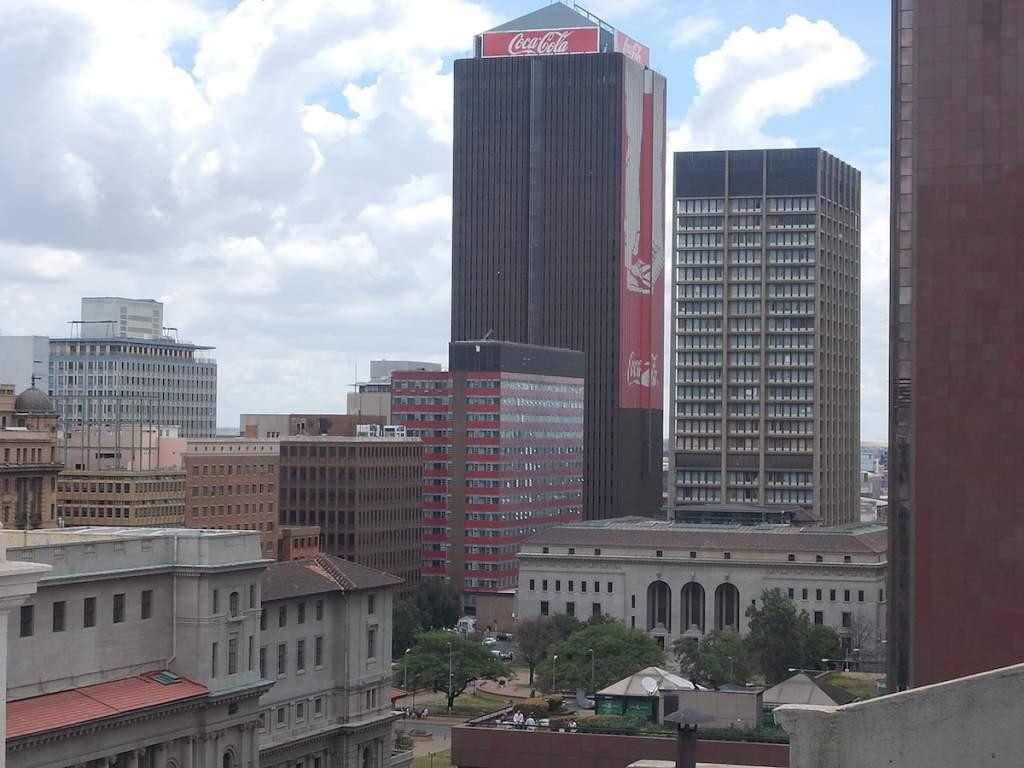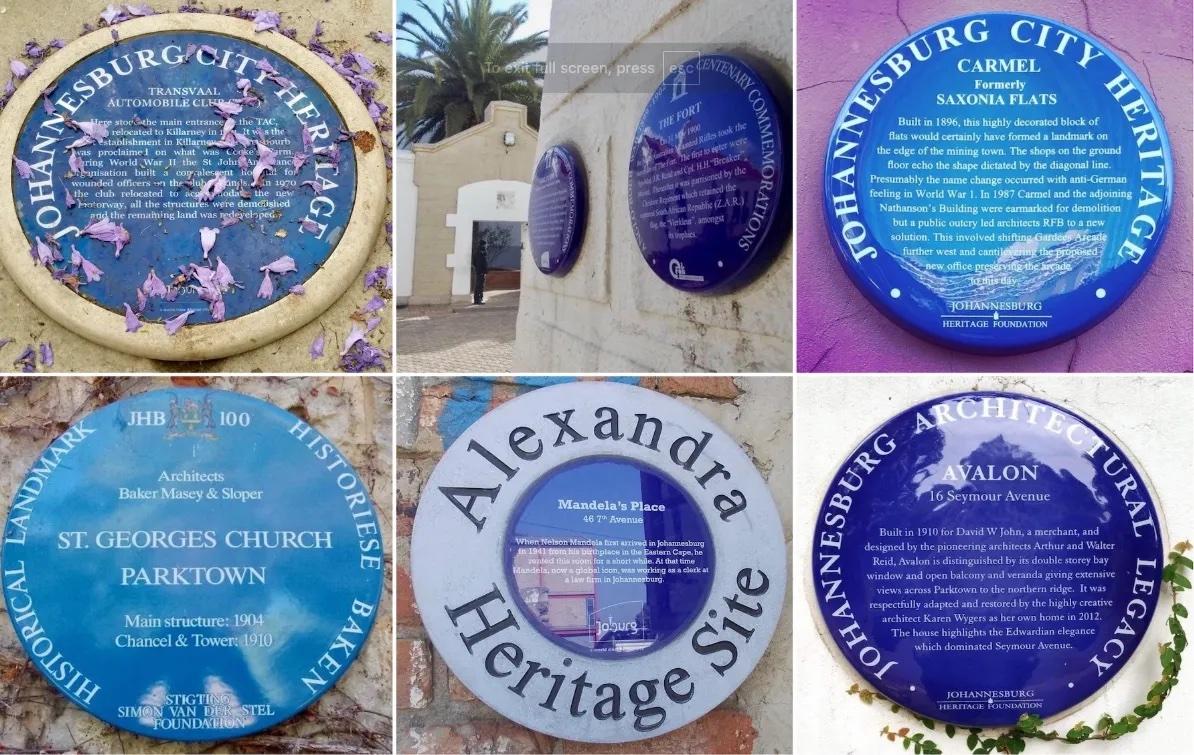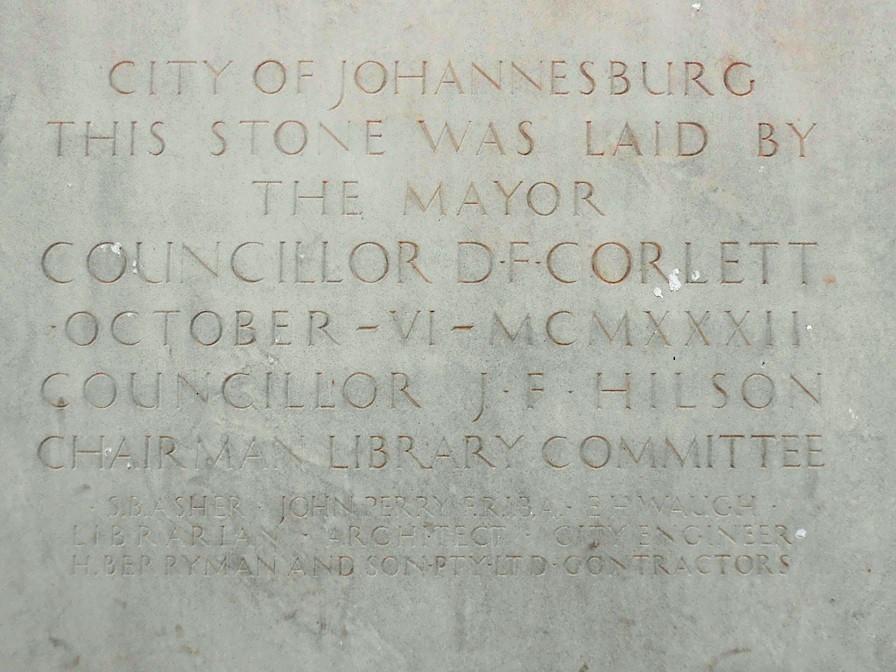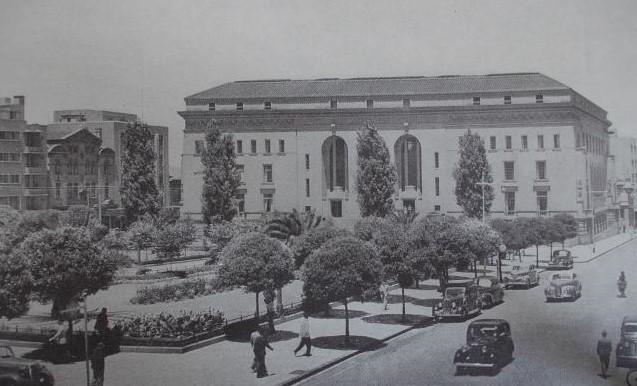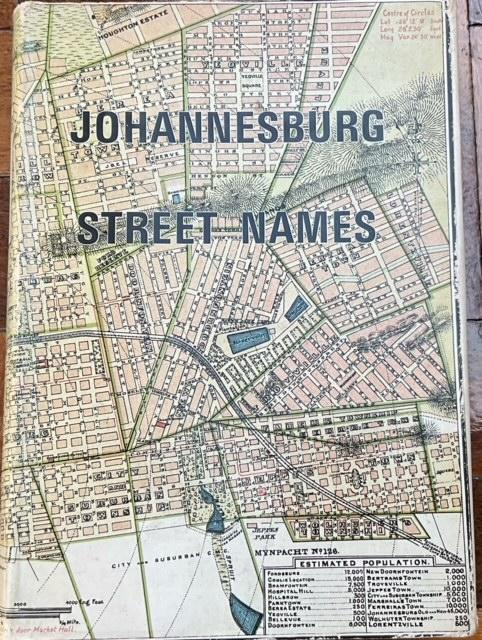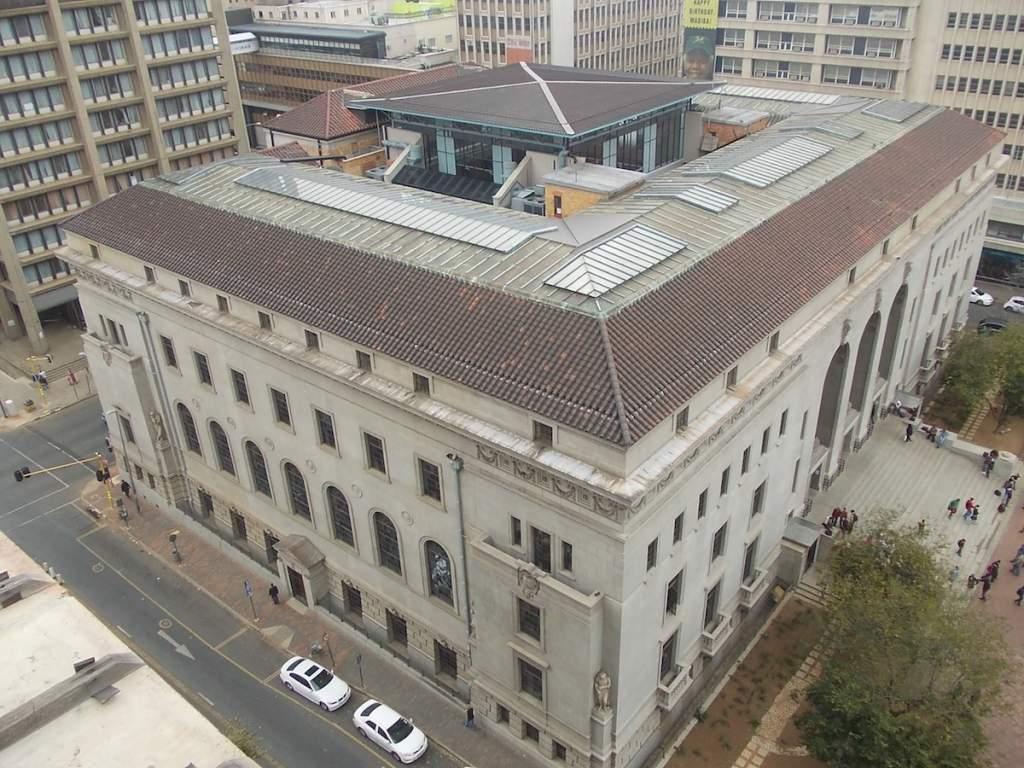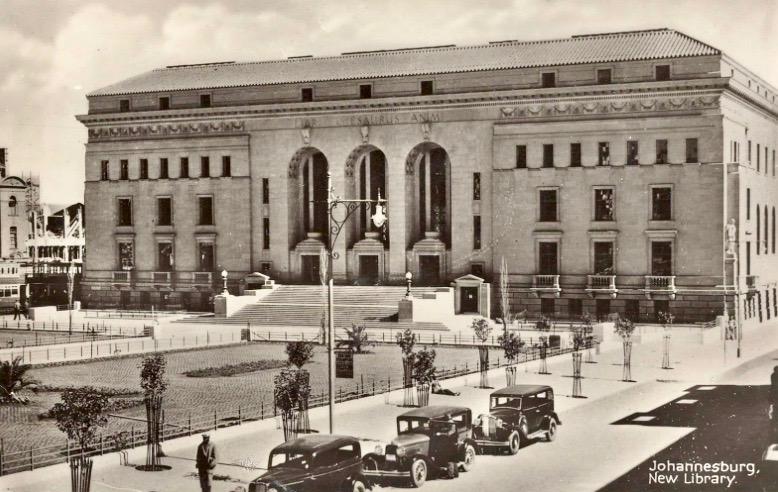
Disclaimer: Any views expressed by individuals and organisations are their own and do not in any way represent the views of The Heritage Portal. If you find any mistakes or historical inaccuracies, please contact the editor.
The Johannesburg City Library has been in the news recently for the wrong reasons, but thankfully, owing to pressure from the Johannesburg Heritage Foundation and the reading public, parts of this important civic facility have been reopened, and after a long closure, it will again be fully functional later in 2025.
Johannesburg Public Library from a. distance (The Heritage Portal)
This may be an appropriate moment to reflect on the role of the City Librarians who ensured the success of the library and maintained its high stature for so many decades.
One of those outstanding figures was Anna Hester Smith (1912-1992), City Librarian from 1960 to 1975. She was a remarkable woman whose career is worth recounting and whose dedicated work requires recognition. The Johannesburg Heritage Foundation is presently negotiating with the City Council to erect a Blue Plaque to honour Miss Smith near the main library building.
A Blue Plaque, an international symbol, is a permanent sign installed on heritage sites to alert the viewer to an aspect of local history explained briefly on the plaque. The Johannesburg Heritage Foundation (JHF) has taken responsibility for Blue Plaques in Greater Johannesburg because they raise public awareness of our heritage, foster pride, provide information, and encourage the protection and preservation of historical landmarks for future citizens.
Several blue plaques installed around Johannesburg
Anna H. Smith is a worthy recipient of a Blue Plaque to commemorate her work for the City of Johannesburg. As City Librarian and Director of the Africana Museum, she dedicated her professional life to the Johannesburg Public Library and to the citizens of Johannesburg.
The importance of the Johannesburg library is incontrovertible. So vital is a good library to the life of any city or town that, in the 1890s, shortly after the foundation of Johannesburg, a library committee was formed, premises were found, and the first librarian was appointed. Over subsequent years, the library grew with the city, expanding its collections and its staff, utilising additional buildings for storage, and serving growing numbers of citizens. By the 1920s plans were afoot for Johannesburg to become legally designated as a city and it was decided, in 1924, that the library would become the full responsibility of the City Council. Discussions began on constructing a large new library and museum on part of Market Square. The present imposing Italianate building, designed by architect John Perry and built with an all-white labour force, was opened on 6 August 1935. The early development of the Johannesburg library has been explained in detail in the book, The Heart of a City: A History of the Johannesburg Public Library (Cape Town: Juta, 1970), by R.F. (Reginald Frank) Kennedy who was Sub-Librarian and then City Librarian from 1936 to 1960.
Foundation Stone (The Heritage Portal)
Johannesburg Public Library (South African Builder Magazine)
A major city is often known for the quality of its library, and this is the case for Johannesburg. However, any library requires expert financial and professional direction and excellent management to achieve and maintain its high reputation, and in these respects, Johannesburg has been fortunate.
The purpose of any municipal library is to serve the public of that city. This Kennedy did over many decades. The writing of his book, mentioned above, was suggested by his successor – Anna Smith – who believed that the full story of the Johannesburg Public Library was important to record for posterity. And it is her illustrious career as City Librarian and Director of the Africana Museum that the forthcoming Blue Plaque intends to commemorate.
Miss Anna Hester Smith was the daughter of Johannes J. Smith (1883-1949), a prominent Afrikaans academic at the University of Stellenbosch. Her father was an outstanding philologist, and he compiled the first authoritative Afrikaans dictionary in 1926. Her mother was Australian. Growing up surrounded by books and among intellectuals, Anna Smith attended an English-medium school and an Afrikaans university. After obtaining her Master of Arts at Stellenbosch University, she became an assistant in the university library. Finding the work interesting, she decided to become a librarian. However, at that time there were no library schools or degrees in South Africa, and she had to take the courses of the South African Librarian Association (SALA) by correspondence. (SALA was a professional organization for librarians with an aim to advance the profession that had been established in 1930 following recommendations from the Carnegie Corporation of New York after a visit to South Africa.)
Anna Smith joined the Johannesburg Public Library in 1938 rising in the hierarchy there until, in 1960, she became City Librarian and Director of the Africana Museum. She gained experience in all aspects of the main library and its various branch libraries and sections, like music and numismatics, as well as its museum collections. She was considered an exceptional librarian with outstanding administrative ability. In recommending her for the position, Kennedy had feared that the Johannesburg city councillors might have preferred a mediocre male to a ‘’brilliant woman’’. Fortunately, they appointed the latter. She was the first woman to head a Council Department in Johannesburg.
Apparently firm, but not aggressive, she was likeable and approachable. She enjoyed working with the Johannesburg City Council, despite the bureaucracy that is inevitable in these situations, and she knew how to cope with the library’s dependence on the finances of the city and its economic condition. She loved her work, was highly regarded by her colleagues and by visitors to the library who were always welcome in her office. The workload increased with the population that used the library and the number of books and items that were acquired. But Smith, the first woman in South Africa to head a major lending and research library and extensive museum and archival collections, was more than equal to the task.
Her organisational skills had never been in doubt and were matched only by her energy. In 1940, with Kennedy, she had driven back and forth to Western Native Township to stock the first library for Africans – the Winifred Holtby Memorial Library. Its first head was librarian Gilbert Pewa, trained by the Johannesburg Library and awarded the SALA diploma which remained the only professional training in librarianship for many years.
When the Black residents of Western Native Township were forcibly removed to Moroka, their library went with them. A new branch was subsequently created for the Coloured people of Westbury (formerly Western Native Township).
A mobile library was introduced to reach areas where there were no branch libraries, and a service for the “shut-ins”, i.e. people immobilised at home, was also introduced. The stack below the parking garage was created in 1960 and accommodated some 40 km of shelving – testimony to its vast collections.
During Smith’s tenure, in 1974, the main Johannesburg Public Library opened its doors to Black and Coloured readers. Her belief, and that of the city council at the time, was that the library should be inclusive of all citizens and available to them. Smith’s philosophy was to encourage literacy and a love of books as well as an appreciation of reliable information.
In July 1965, Anna Smith published an article in the journal Library Trends, a special issue devoted to ‘’Metropolitan Public Library Problems Around the World’’. Smith’s contribution, ‘’The Public Libraries of Johannesburg’’, was accompanied by articles on the theme from the public libraries of Warsaw, East Berlin, Vienna, Stockholm, Tokyo, Los Angeles, New York, Greater London and other large cities. Johannesburg’s library was thus counted among other great city libraries of the world. What Anna Smith had to say in her article gives a sense of the Johannesburg Public Library during the period she was working there.
She detailed how Kennedy had persuaded the City Council to institute libraries in schools, fire stations, factories, and hospitals; to introduce suburban branch libraries for Blacks and whites alike; to establish travelling libraries, a formal music collection, as well as special library facilities for City Councillors, together with other innovations. Smith also mentioned the tutorial classes organised at the Johannesburg Public Library to train aspiring librarians and the fact that her staff assisted universities as part-time lecturers and examiners. Together with her description of other aspects of the public library, she included particulars of its relationship with the City Council that funded it from rates, and how that Council ‘’considered it both a duty and a privilege to maintain an efficient library service for its citizens ...”. Certainly, the Johannesburg Library excelled in providing that service.
In explaining the problems that she and the library faced in Johannesburg, Smith noted the wide range of local languages that were spoken and in which reading materials were required; the citizens’ differing standards of living, educational backgrounds, religious views and – for some sections of the borrowing public – the lack of a library tradition. She also outlined the high demand from Black library users for informative rather than recreational reading, as well as the overwhelming numbers of Black children clamouring for study books. Smith was pleased to inform her international colleagues that illiteracy had declined but admitted that more needed to be done for Black users. She also stated that the library needed to expand physically as the building had not been altered for thirty years. In concluding her contribution, Smith showed herself aware of changing technology – ‘’computer methods’’ as she called them – and realised that they would be important in taking the library forward in the future.
Not only did Smith consider it to be her responsibility to run the library and museum efficiently and professionally and meet those challenges, she also believed that it was her duty, as custodian of some of South Africa’s important historical, or Africana, material that was inaccessible to visitors, to publicise and educate the Johannesburg public about the treasures that were held in their name within the library as well as to celebrate the history of Johannesburg, their city.
Despite her extremely busy schedule, Smith published, compiled or edited numerous books and articles, some of them of major importance. Among them are:
- Claudius water-colours in the Africana Museum (Johannesburg: Africana Museum, 1952)
- Pictorial History of Johannesburg (Johannesburg: Juta for the Africana Museum, 1956)
- The Language of Stamp Collecting / Die Taal van die Posseelversamelaar (Johannesburg: Public Library, 1959)
- “Early Johannesburg in sickness and in health”, Johannesburg: Institute for the Study of Man in Africa No. 12, 1962 19pp.
- ‘’South African portraits’’, Familia 1(1) 1964: 19-21.
- ‘The Public Libraries of Johannesburg’’, Library Trends 14(1) 1965: 7-13.
- “Problems of Cape silver’’, Johannesburg: Institute for the Study of Man in Africa No. 27, 1970 8pp.
- Johannesburg Street Names: A Dictionary of Street, Suburb and Other Place-names Compiled to the end of 1968 (Cape Town: Juta, 1971)
- The Spread of Printing: Eastern Hemisphere, South Africa (Leiden: Brill, 1971). (Volume published as part of the series The Spread of Printing: A History of Printing Outside Continental Europe and Great Britain.
- Africana Curiosities (Johannesburg: Ad. Donker, 1973)
- “Collecting South African costume”, Costume 9(1) 1975: 59.
- Africana Byways (Johannesburg: Ad. Donker, 1976)
- Sketches by Ida Mae Stone and Harry Clayton (Johannesburg: Ad. Donker for the Africana Museum, 1976)
- ‘’Oosthuizen and Johannesburg’’, Familia 13(4) 1976: 98.
- Johannesburg Firsts: Johannesburg 1886-1976 Anniversary (Johannesburg: Africana Museum, 1976)
- Chronology of Johannesburg (Johannesburg: Africana Museum, 1977)
- Treasures of the Africana Museum (Cape Town: Purnell, 1977)
- ‘’Illustrated Books of Africana”, Bibliophilia Africana III: Being the Proceedings of the Third Conference of South African Bibliophiles, held at the University of the Witwatersrand Library, Johannesburg, May 2-5, 1978, vol. 3, p. 26. Friends of the University of the Witwatersrand Library, 1978.
One of Anna Smith's well-known titles
She was the editor of the journal Africana Notes and News during the period she was City Librarian and was the backbone of this publication in the 1960s and 1970s. Moreover, she oversaw the Library’s important annual publication, the Index to South African Periodicals.
Anna Smith retired in 1975 leaving the City the best stocked and most highly developed municipal library in the country.
Johannesburg Public Library from above (The Heritage Portal)
Jane Carruthers is Professor Emeritus at the University of South Africa, elected Fellow of the Royal Society of South Africa and Member of the Academy of Science of South Africa. She has been awarded many international visiting research Fellowships, including at Cambridge University, the Australian National University and others. She is a former President of the International Consortium of Environmental History Organizations, the Southern African Historical Society, Chair of the Academic Board of the Rachel Carson Centre Ludwig Maximilian University, Munich, Editor-in-Chief of the South African Journal of Science, and recipient of the Distinguished Scholar Award from the American Society for Environmental History. She pioneered the discipline of environmental history in South Africa and her book, The Kruger National Park: A Social and Political History (1995) has become a standard reference worldwide. Her research interests are broad, and include environment history, national parks, the history of science, land reform, colonial art, ad comparative Australian-South African history. She is the author of numerous books, as well as many book chapters and articles in scholarly journals.
Kathy Munro is an Honorary Associate Professor in the School of Architecture and Planning at the University of the Witwatersrand. She enjoyed a long career as an academic and in management at Wits University. She trained as an economic historian. She is an enthusiastic book person and has built her own somewhat eclectic book collection over 40 years. Her interests cover Africana, Johannesburg history, history, art history, travel, business and banking histories. She researches and writes on historical architecture and heritage matters. She is a member of the Board of the Johannesburg Heritage Foundation and is a docent at the Wits Arts Museum. She is currently working on a couple of projects on Johannesburg architects and is researching South African architects, war cemeteries and memorials. Kathy is a member of the online book community the Library thing and recommends this cataloging website and worldwide network as a book lover's haven. She is also the Chairperson of HASA.
Flo Bird is a tireless heritage activist and co-founder of the Johannesburg Heritage Foundation, previously the Parktown and Westcliff Heritage Trust. She has led a decades-long crusade to preserve the architectural and cultural legacy of Johannesburg. She has saved countless historic buildings from demolition, helped establish the blue plaque programme in the city , and inspired a new generation of heritage conservationists in South Africa. She is a fighter who loves her city.
Comments will load below. If for any reason none appear click here for some troubleshooting tips. If you would like to post a comment and need instructions click here.

